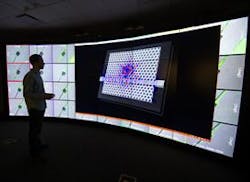New DoD, AIM Photonics partnership to create sensors for photonic systems
The U.S. Department of Defense (DoD) will fund researchers developing photonic sensors for applications such as environmental monitoring, disease diagnosis, chemical and biological weapons detection, and food safety. The $900,000 project will be supported by $1.41 million in funds from the American Institute for Manufacturing Integrated Photonics (AIM Photonics) industrial members led by the University of Rochester. The consortium includes the U.S. Army, U.S. Navy Research Lab, Ortho-Clinical Diagnostics, Analog Photonics, the University of Tulsa, PhoeniX, the University of California-Santa Barbara, and OndaVia.
“Sensors represent the interface between the real world and data,” said Ben Miller, the principal investigator of the project. “Developing a universal set of protocols to design, manufacture, modify, and integrate sensors into photonics systems will not only advance this technology, but also present a tremendous economic opportunity—integrated photonics sensors represent a large and rapidly growing market, potentially reaching more than $15 billion globally by 2020.”
Miller is a professor in the University of Rochester Departments of Dermatology and Biomedical Engineering and the Institute of Optics. He is also the academic lead of the AIM Photonics Sensors Key Technology Manufacturing Area. The project will focus on developing manufacturing blueprints for photonics-based transducers—the part of the sensor that interacts with what is being detected so that these components can be mixed and matched by manufacturers to build systems that identify a wide range of chemical or biological targets.
The project will involve close collaboration between government, academic, and industry researchers and engineers. The work to model, design, and fabricate the sensor components will be performed at the new AIM Photonics Testing, Assembly, and Packaging facility at Eastman Business Park in Rochester, the University of Rochester Medical Center, and SUNY Polytechnic Institute.

Conard Holton
Conard Holton has 25 years of science and technology editing and writing experience. He was formerly a staff member and consultant for government agencies such as the New York State Energy Research and Development Authority and the International Atomic Energy Agency, and engineering companies such as Bechtel. He joined Laser Focus World in 1997 as senior editor, becoming editor in chief of WDM Solutions, which he founded in 1999. In 2003 he joined Vision Systems Design as editor in chief, while continuing as contributing editor at Laser Focus World. Conard became editor in chief of Laser Focus World in August 2011, a role in which he served through August 2018. He then served as Editor at Large for Laser Focus World and Co-Chair of the Lasers & Photonics Marketplace Seminar from August 2018 through January 2022. He received his B.A. from the University of Pennsylvania, with additional studies at the Colorado School of Mines and Medill School of Journalism at Northwestern University.
